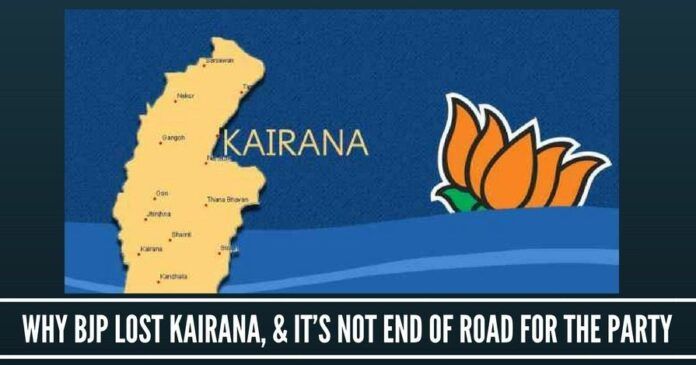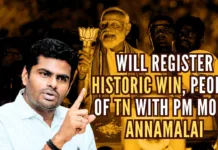
The community was upset with the ‘failure’ of the BJP Government in neighbouring Haryana to extend reservations to Jats in Government institutions
Political pundits are saying that the Kairana outcome is a wake-up call for the Bharatiya Janata Party, especially in Uttar Pradesh. It’s not; instead, it is a loud alarm bell that only a politically deaf party can fail to hear — and not even the worst critic can accuse the BJP of being politically inept. The wake-up call was the twin defeat in the Lok Sabha by-elections to Gorakhpur and Phulpur. Nearly everything that could go wrong for the BJP went wrong in Kairana, and nothing that should have gone right did. So, how and why did things go wrong?
Further puzzling is that fact that the Jats seemed unmoved by the Yogi Adityanath Government’s decision to withdraw cases against many members of the Hindu community in connection with those communal disturbances
On paper, the BJP should not have faced defeat even when confronted with a common opposition candidate. Such a candidate ought to have at best cornered nearly all of the Muslim votes polled as well as a section of the Scheduled Caste votes. This happened because of two obvious reasons. The first is that Muslims by and large do not vote for the BJP. The second is that the RLD had fielded a Muslim candidate.
The Scheduled Castes voted, in significant numbers, for the RLD, again for two reasons. The first is because the Bahujan Samaj Party had not put up its candidate and had instead tacitly backed the RLD nominee. The second is the prevailing perception that the BJP has been “anti-Dalit” — something that is probably more propaganda than real. Taken together, the Muslims and a good section of the Scheduled Castes were a formidable force.
ut there was the large voting population of the rest — the Jats, the non-Yadav Other Backward Classes, the upper castes — that could have foiled the joint opposition’s plans. This did not happen because a big percentage of the Jat community voted for the RLD. This was a turnaround from 2014 and 2017, when the Jats aligned with the BJP in majority numbers. Commentators are wondering how the Jat voters could team up with the Muslims, given the communal environment there (more so in the shadow of the Muzaffarnagar riots). Even more confounding is that these voters should have backed a Muslim candidate. Further puzzling is that fact that the Jats seemed unmoved by the Yogi Adityanath Government’s decision to withdraw cases against many members of the Hindu community in connection with those communal disturbances. They were also not impressed by the BJP’s attempt to drag in the Jinnah controversy in the electoral arena.
None of these improbable would have happened in normal circumstances. But Kairana is a sugar belt and sugar cane cultivators, which included Jats in large numbers, were deeply aggrieved over the delay in the payment of their produce. It’s true that the Yogi Government had seen to the release of these outstanding amounts, but the initiative came too late and was too little. Besides, the community was upset with the ‘failure’ of the BJP Government in neighbouring Haryana to extend reservations to Jats in Government institutions. To top it all, there was a colossal failure by the BJP leaders, both at the local and the State levels, to reach out to the angry Jat voters in the region and ‘manage’ them. Call it arrogance or miscalculation, they had thought the community had nowhere to go but to the BJP, given the social dynamics. This failure, according to some BJP workers, was not just limited to the State and local leadership; it extended to the central leadership as well, which, perhaps complacent by a string of electoral successes, failed to gauge grassroots sentiments. It happened, incidentally, also in Phulpur and Gorakhpur, where rumblings were heard over the poor choice of candidates by the higher-ups.
In their over-zealousness to celebrate the ‘united opposition’s’ victory over the Modi-led BJP, various regional leaders from Mamata Banerjee to Arvind Kejriwal to Tejaswi Yadav have already written off the BJP and the Prime Minister for 2019
But there is another set of facts, and this should offer the BJP a way out to do course-correction. The BJP had polled a little over 50 percent of votes in 2014, whereas this time around the vote-share dipped to 46.5 percent. While this is a sharp fall, the fact that more than 46 percent voted for the BJP as against a joint candidate, indicates that a solid consolidation of the non-Muslim/non-Jat/non-Dalit votes took place. The RLD candidate received few non-Muslim and non-Dalit votes. Therefore, had the BJP tweaked the Jat votes in time, the united opposition’s candidate would have fallen flat on the face. It must be remembered, meanwhile, that a mere consolidation of the non-Muslim/non-Dalit votes would not have fetched the BJP the 46 percent vote share it got; a section of the Jats did vote for the party — though not in enough numbers to make a difference in the party’s favour.
The other factor which went against the BJP, which was seeking to retain the seat, was the low voter turnout. The voting percentage had been at just 54 percent — nearly 15 percent less than in 2014. It is generally assumed that a higher turnout signals the desire for change and a low voter percentage work to the incumbent’s advantage. But that is a simplistic assumption since what is important to observe is the kind of people who arrive at the polling booths. It can be safely assumed that given the fact that the RLD candidate was a Muslim and that the party was seeking to recalibrate its profile from being a Jat party to one that was more inclusive — a task which was made easier by the support the Samajwadi Party and the BSP had extended — the Muslim voters came out in good numbers and voted for the RLD. Let’s not forget that Muslims account for nearly 35 percent of Kairana Lok Sabha constituency’s population. Had other voters too come out in full strength, it is possible that there would have been many more of those who would have pressed the button for Lotus. That they didn’t turn out, is something that local BJP leaders have to answer for.
In their over-zealousness to celebrate the ‘united opposition’s’ victory over the Modi-led BJP, various regional leaders from Mamata Banerjee to Arvind Kejriwal to Tejaswi Yadav have already written off the BJP and the Prime Minister for 2019. If they care to read the fine print in their triumphs, they would be less enthusiastic.
Note:
1. The views expressed here are those of the author and do not necessarily represent or reflect the views of PGurus.











Good analysis. Want BJP to win at any cost.
Tu toh sale propaganda chala raha hai
Jats aggrieved with the BJP for not getting reservations inHaryana, and notvenough ganna money , vote for non BJP candidate as the best alternative? They are now assured good ganna price and reservations in Kairana and reservations? There is usually some logic in human reasoning. I am definitely missing something .. even world renowned psychologists would fail in analysing this one.
Surprising that crucial issues do not find a mention at all in this article.
The following article is an eye opener on Khairana By poll.
http://indianexpress.com/article/india/ganna-trumps-jinnah-in-kairana-bypoll-when-sugarcane-arrears-pile-up-5184737/
Surprising that crucial issues do not figure in this article at all.
The following article should be an eye opener.
http://indianexpress.com/article/india/ganna-trumps-jinnah-in-kairana-bypoll-when-sugarcane-arrears-pile-up-5184737/